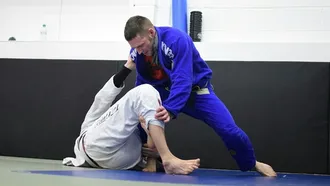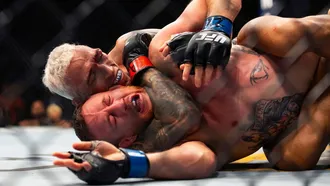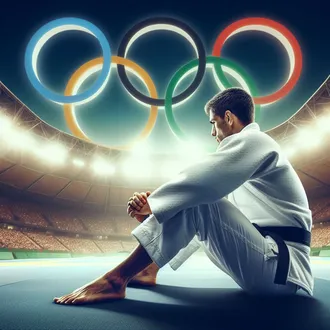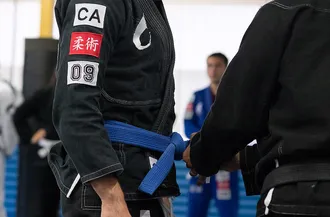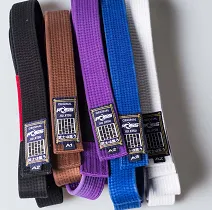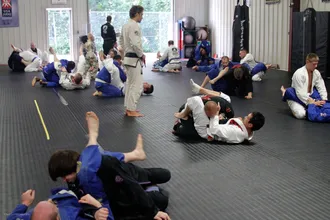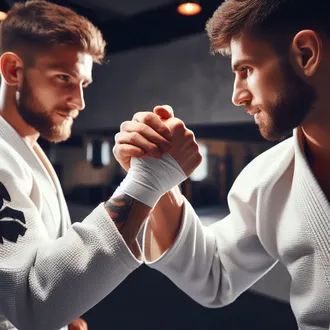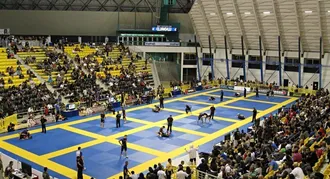
Welcome to the Competitive World of Brazilian Jiu-Jitsu (BJJ)
Brazilian Jiu-Jitsu (BJJ) is far more than just a standard martial art—it is a dynamic, high-pressure combat sport that relentlessly challenges both your physical capabilities and your mental acuity. When you step up to enter a BJJ competition, you are providing yourself with a unique, irreplaceable opportunity to pressure-test your skills, sharpen your technical application, and experience significant growth both mentally and physically.
It doesn't matter if you are competing for the very first time or if you are a seasoned veteran looking to refine your strategy; developing a deep understanding of how BJJ tournaments operate is essential for success. From the adrenaline-fueled intensity of the matches to the specific nuances of structured ranking systems, competition forces you to step way beyond your comfort zone. It is this pressure that helps you evolve into a stronger, more confident, and more technical grappler.
If you are brand new to the sport and feeling unsure, taking the time to familiarize yourself with the typical training environment found in academies can give you a solid baseline of what to expect before you ever step onto the competition mats.
- Welcome to the Competitive World of Brazilian Jiu-Jitsu (BJJ)
- What to Expect in Your First BJJ Tournament
- The Importance of Preparation for First-Time BJJ Competitors
- Understanding BJJ Competitions: Rules, Scoring, and Formats
- How Do BJJ Competitions Work? Rules and Scoring Explained
- BJJ Rules and Scoring System: How Points Are Earned
- BJJ Match Formats and Victory Conditions: How Matches Are Won
- IBJJF Weight Classes: Standard Divisions for Gi & No-Gi
- ADCC Weight Classes: No-Gi Submission Grappling Divisions
- Grappling Industries Weight Classes: Flexible Tournament Divisions
- Importance of Selecting the Right Weight Class for BJJ Competitions
- Should You Cut Weight for a BJJ Tournament? Pros & Cons
- Preparing for Your First BJJ Competition: Key Training Tips
- How Long Should You Train Before Competing in BJJ?
- Balancing Training and Competition Preparation in BJJ
- What Should You Eat Before a BJJ Competition? Nutrition for Peak Performance
- Mental Preparation for BJJ Competition: Build Confidence & Focus
- Technical Skill Development for BJJ Competition
- Mastering Fundamental BJJ Techniques for Competition Success
- Strategies for Refining Specific Techniques and Positions in BJJ
- BJJ Drilling and Repetition: Building Muscle Memory for Competition
- BJJ Competition Day Strategies: How to Perform at Your Best
- Creating a Pre-Competition Routine for BJJ Tournaments
- Reviewing Your Performance After a BJJ Tournament: Learn and Improve
- Improvement Strategies After a BJJ Competition
- Incorporating Lessons Learned into Future BJJ Training
- Conclusion: Key Takeaways for BJJ Competition Success
What to Expect in Your First BJJ Tournament
BJJ tournaments are high-energy, chaotic events where practitioners from various academies come to put their training to the ultimate test. The atmosphere is often electric and vastly different from your gym—crowds are cheering, competitors are frantically warming up in the bullpen, and you can feel the adrenaline surging as matches unfold on multiple mats simultaneously. Whether you are a complete beginner or a seasoned competitor, stepping onto that mat brings a mix of intense excitement and inevitable nerves.
Picture yourself waiting for your match. Your heart is racing, and you are trying to stay warm as the referee signals the start. The moment you engage with your opponent, every technique you have drilled comes into play. From executing takedowns to fighting for positional control, Brazilian Jiu-Jitsu competitions challenge your ability to stay composed and make smart decisions under heavy pressure.
While these events feel very different from your day-to-day rolling, understanding how standard sessions are structured will show you how your daily grind and sparring rounds are specifically designed to prepare you for these live tournament settings.
The Importance of Preparation for First-Time BJJ Competitors
Preparation is absolutely everything when you are stepping into your first BJJ tournament. Success on the mats isn’t just about raw talent or athleticism—it is about structured training, intelligent strategy, and developing mental resilience. The way you prepare in the weeks leading up to the event will directly impact your confidence levels and your actual performance on competition day.
You should think of it like getting ready for a massive final exam: the more effort you put into drilling specific techniques, improving your cardiovascular endurance, and sharpening your competitive mindset, the better your results will be. From perfecting your fundamental "A-Game" techniques to fully understanding the competition rules, the right preparation can make a huge difference in your experience.
Many students monitor their progress by benchmarking against the average time required to reach the first major rank, which offers a good baseline for judging your skill progression before signing up.
Understanding BJJ Competitions: Rules, Scoring, and Formats
BJJ competitions follow strictly structured rules and scoring systems designed to ensure fairness and safety for all participants. Whether you are stepping into a local recreational tournament or competing at a high-level international competeition, knowing exactly how the competition works is crucial for your success.
Matches can follow drastically different formats depending on the organization. You might see submission-only tournaments, where the only way to win is by tapping your opponent, or point-based scoring systems, where victory is determined by submissions, points, or advantages accumulated over time. The ability to strategize based on the specific rule set you are fighting under can be the difference between winning gold and going home early.
Competitors looking at the long-term journey often analyze the dedication required to reach mastery and the highest belt ranks to better understand the deep level of commitment needed for high-level competition.
How Do BJJ Competitions Work? Rules and Scoring Explained
Success in a BJJ tournament isn’t just about physical skill—it’s also about understanding the rules and scoring system. Knowing how points, advantages, and penalties work can prevent you from making costly mistakes and give you a massive competitive edge over someone who just showed up to fight.
Think of a match like a strategic game: understanding the rules is like having a roadmap to victory. Competitors earn points for demonstrating positional control, executing takedowns, sweeping opponents, and attempting submissions, while penalties are strictly given for stalling or executing illegal moves.
To fully grasp the rankings and who you will be fighting within these tournaments, reviewing the hierarchy of colored belts and promotion criteria clarifies the significance and experience level of each division.
BJJ Rules and Scoring System: How Points Are Earned
The BJJ scoring system adds deep layers of strategy to each match, rewarding competitors for positional control, submission attempts, and technical execution. Understanding exactly how and why points are awarded can help you refine your game plan and maximize your scoring opportunities.
Here is a detailed breakdown of the key scoring criteria used by major federations like the IBJJF:
- Takedowns (2 points): Successfully bringing your opponent to the ground and maintaining top position for 3 seconds sets the tone for the match.
- Guard Passes (3 points): Moving past your opponent’s legs (guard) and establishing a dominant side control or north-south position is a major advantage.
- Mount & Back Control (4 points): Securing these high-value positions gives you ultimate control and opens up the highest percentage submission opportunities.
- Sweeps & Reversals (2 points): Turning a defensive guard position into a dominant top position can completely shift the momentum of a match.
While points matter immensely, some competitors prefer an aggressive submission-based approach rather than "playing the game" for points. Your strategy should align with your personal strengths and the specific tournament format.
Common Illegal Moves: Don't Get Disqualified
Nothing is worse than training for months only to get disqualified (DQ) in ten seconds for an illegal move. Safety rules vary by belt level, but there are some universal "No-Gos" for white and blue belts in most Gi tournaments.
| Move | Legality (White/Blue Belt) | Why? |
|---|---|---|
| Slams | Illegal | High risk of spinal injury. You must put opponents down safely. |
| Heel Hooks | Illegal (in Gi) | Can cause severe knee damage before you feel pain. |
| Reaping the Knee | Illegal (in Gi) | Forcing the opponent's knee inward past a natural angle. |
| Scissor Takedown | Illegal (White Belt) | High risk of knee injury if timed poorly. |
| Wrist Locks | Illegal (White Belt) | Allowed at Blue belt and above in IBJJF. |
Note: Always check the specific rule book for your tournament, as NAGA, Grappling Industries, and IBJJF all have slight variations.
BJJ Match Formats and Victory Conditions: How Matches Are Won
BJJ competitions use several different match formats, each with unique victory conditions. Whether you’re competing in a traditional point-based tournament or a submission-only event, understanding the rules will help you tailor your strategy.
Here are the most common BJJ match formats you will encounter:
- Point-Based Matches: The competitor with the most points at the end of the time limit wins. Points are awarded for takedowns, positional control, and sweeps.
- Submission-Only: Matches have no points—victory comes only by making your opponent tap out. If time runs out, it may result in a draw or a referee decision.
- Timed Rounds: Matches typically last 5 to 10 minutes depending on the belt level and tournament rules.
- Golden Score (Overtime Rounds): If there’s a tie at the end of regulation, some tournaments introduce an overtime round where the first competitor to score wins immediately.
Each format requires a different approach. Point-based matches often favor strategic players who can control the tempo, while submission-only tournaments reward an aggressive, attack-oriented style.
IBJJF Weight Classes: Standard Divisions for Gi & No-Gi
The IBJJF (International Brazilian Jiu-Jitsu Federation) is one of the most recognized BJJ organizations in the world, using standardized weight classes for both gi and no-gi competitions. These divisions ensure fair matchups and help competitors plan their competition strategy effectively.
Here is a breakdown of the IBJJF men’s gi weight classes:
| IBJJF Men's Gi Weight Class | Maximum Weight (kg) | Maximum Weight (lbs) |
|---|---|---|
| Rooster | 57.5 kg | 127 lbs |
| Light Feather | 64 kg | 141 lbs |
| Feather | 70 kg | 154 lbs |
| Light | 76 kg | 167.5 lbs |
| Middle | 82.3 kg | 181.5 lbs |
| Medium Heavy | 88.3 kg | 195 lbs |
| Heavy | 94.3 kg | 208 lbs |
| Super Heavy | 100.5 kg | 221.5 lbs |
| Ultra Heavy | No limit | No limit |
For women's divisions, the IBJJF weight classes follow a similar format but with adjusted weight limits. These divisions ensure fair competition by matching athletes against similarly built opponents.
Uniform Requirements: Gi and No-Gi Rules
Showing up on weight is useless if your uniform fails the check. Referees can—and will—disqualify you for the wrong gear. It is vital to check your gear before you leave the house.
- Gi Colors: In IBJJF, you can strictly only wear White, Royal Blue, or Black. No mismatched jackets and pants are allowed.
- Gi Fit: The sleeves must reach your wrists when arms are extended, and there must be enough slack for the referee to grab. If your Gi shrunk in the wash, you might fail inspection.
- No-Gi Rash Guards: Major tournaments often require a rash guard that is at least 10% the color of your belt rank to help refs identify you.
- Hygiene: Clean gear, trimmed fingernails, and long hair tied back are mandatory.
ADCC Weight Classes: No-Gi Submission Grappling Divisions
ADCC (Abu Dhabi Combat Club) is one of the most prestigious no-gi grappling organizations in the world, focusing on submission wrestling rather than point-based scoring. Unlike IBJJF tournaments, ADCC follows its own weight class system, structured differently to accommodate No-Gi competition dynamics.
Here is a breakdown of the ADCC men’s weight divisions:
| ADCC Men's Division | Maximum Weight (kg) | Maximum Weight (lbs) |
|---|---|---|
| Under 66 kg | 66 kg | 145 lbs |
| Under 77 kg | 77 kg | 169 lbs |
| Under 88 kg | 88 kg | 194 lbs |
| Under 99 kg | 99 kg | 218 lbs |
| Over 99 kg | No limit | No limit |
ADCC also includes an absolute division, where competitors from all weight classes can compete against each other, emphasizing skill, endurance, and technique over weight advantage.
Training methodologies often change depending on the format, so understanding the key differences between grappling with and without the kimono is vital for preparation.
Grappling Industries Weight Classes: Flexible Tournament Divisions
Grappling Industries tournaments use a unique format, blending elements of IBJJF and ADCC rules while allowing more flexibility in weight divisions. Unlike more rigid organizations that use single-elimination, Grappling Industries adjusts divisions based on competitor registrations and uses a "Round Robin" format to ensure balanced matchups and more fights for your money.
Below are the official weight classes for men’s and women’s divisions in both gi and no-gi:
Men's Gi & No-Gi Weight Classes
| Weight Class | Maximum Weight (lbs) | Maximum Weight (kg) |
|---|---|---|
| -115 lbs | 115 lbs | 52 kg |
| -125 lbs | 125 lbs | 57 kg |
| -135 lbs | 135 lbs | 61 kg |
| -145 lbs | 145 lbs | 66 kg |
| -155 lbs | 155 lbs | 70 kg |
| -170 lbs | 170 lbs | 77 kg |
| -185 lbs | 185 lbs | 84 kg |
| -200 lbs | 200 lbs | 91 kg |
| -215 lbs | 215 lbs | 97.5 kg |
| -230 lbs | 230 lbs | 104 kg |
| +230 lbs | Over 230 lbs | Over 104 kg |
Women's Gi & No-Gi Weight Classes
| Weight Class | Maximum Weight (lbs) | Maximum Weight (kg) |
|---|---|---|
| -105 lbs | 105 lbs | 48 kg |
| -115 lbs | 115 lbs | 52 kg |
| -125 lbs | 125 lbs | 57 kg |
| -135 lbs | 135 lbs | 61 kg |
| -145 lbs | 145 lbs | 66 kg |
| -155 lbs | 155 lbs | 70 kg |
| -170 lbs | 170 lbs | 77 kg |
| -185 lbs | 185 lbs | 84 kg |
| -200 lbs | 200 lbs | 91 kg |
| +200 lbs | Over 200 lbs | Over 91 kg |
Why Grappling Industries Weight Classes Are Different
- Flexible Divisions: Divisions are adjusted based on the number of registered competitors, ensuring balanced brackets.
- Round-Robin Format: Unlike single-elimination tournaments where one loss sends you home, Grappling Industries guarantees multiple matches per competitor.
- More Competition Time: More mat time per event allows for valuable experience in both gi and no-gi divisions.
Grappling Industries also provides a 1.0 lb weight allowance for adult divisions.
Importance of Selecting the Right Weight Class for BJJ Competitions
Choosing the right BJJ weight class is a crucial part of your overall competition strategy. Competing at your natural weight can improve your endurance and strength, while some athletes opt to cut weight to enter a lower division. However, extreme weight cutting can negatively impact performance.
Weigh-In Logistics: When Do You Step on the Scale?
One of the biggest sources of anxiety for new competitors is the weigh-in timing. This changes strictly based on the organization, so pay close attention:
- IBJJF Rules (Gi): You weigh in moments before your first match, and you must weigh in WEARING your Gi. A Gi can weigh 3-5 lbs, so you must account for this, or you will be disqualified immediately.
- ADCC / No-Gi Events: You usually weigh in without the Gi (shorts/rashguard), sometimes an hour before the bracket starts, or even the day before depending on the event level.
Always read the specific event packet to confirm if you have a weight allowance or if the weigh-in is "Gi-On."
Factors to Consider When Choosing a Weight Class
- Endurance & Strength: Competing at your natural weight allows for better conditioning and sustained energy levels throughout the day.
- Skill vs. Size: Some competitors prioritize technique over size and prefer to fight in absolute (open weight) divisions.
- Weight Cutting Risks: Rapid weight loss can lead to fatigue, dehydration, and reduced strength on match day.
- Recovery Time: If you cut weight, consider how much time you have to rehydrate before your first match. In IBJJF, you have almost zero time.
While some competitors successfully cut weight for tournaments, others find that fighting at their natural weight leads to better performance and recovery.
Should You Cut Weight for a BJJ Tournament? Pros & Cons
Many competitors consider cutting weight before a tournament to enter a lower division and gain a potential size advantage. However, this strategy comes with significant risks and isn’t always the best approach, especially for beginners.
Pros of Cutting Weight
- Size Advantage: Competing in a lower weight class may mean facing smaller, potentially weaker opponents.
- Increased Strength-to-Weight Ratio: If done correctly, a controlled weight cut can maximize strength while staying within a lighter division.
- Common Strategy in High-Level Competition: Many advanced competitors successfully cut weight to optimize performance.
Cons of Cutting Weight
- Risk of Dehydration: Extreme weight cutting can drain energy levels and negatively affect your endurance and cardio.
- Loss of Strength: Losing weight too quickly can result in muscle loss and decreased explosive power.
- Increased Stress: Cutting weight adds additional mental and physical stress before competition day, distracting you from the fight itself.
For first-time competitors, it's usually best to compete at your natural weight rather than focusing on drastic weight loss. Prioritizing technical skill, conditioning, and mindset will have a much bigger impact on performance than weight manipulation.
Preparing for Your First BJJ Competition: Key Training Tips
Entering your first BJJ tournament can be both exciting and nerve-wracking. While technical skill plays a huge role, success in competition also depends on consistent training, physical conditioning, and mental preparation.
To perform at your best, you’ll need to fine-tune your techniques, improve endurance, and develop a strong competition mindset. Below, we break down the key areas to focus on before stepping onto the mat.
Essential Areas to Focus on Before Your First Tournament
- Technical Mastery: Drill high-percentage moves, such as guard passes, sweeps, and escapes, until they become second nature.
- Live Sparring: Increase the intensity of your rolls to simulate real competition speed and pressure.
- Competition Rules: Understanding the nuances of regulations and scoring systems can help you avoid costly mistakes.
- Cardio & Strength Training: Improve endurance to sustain a high pace for the entire match without gassing out.
- Mental Preparation: Develop focus and confidence to stay calm under pressure.
With structured training and the right mindset, you'll step onto the mat feeling prepared and ready to compete. Establishing an optimal training frequency is critical to building a solid competition foundation.
How Long Should You Train Before Competing in BJJ?
One of the most common questions beginners ask is, “How long should I train before entering my first BJJ competition?”. The answer depends on your experience, skill level, and overall readiness.
While some white belts compete after just a few months, most coaches recommend training for 6 to 12 months before stepping into a tournament. This allows enough time to build technical proficiency, endurance, and confidence.
Key Readiness Factors
- Technical Proficiency: You should be comfortable with fundamental techniques, including guard passes, sweeps, and basic escapes.
- Live Sparring Experience: Have you practiced rolling under competition-like intensity in the gym?
- Cardio & Endurance: Can you maintain a steady pace for an entire match?
- Mental Readiness: Are you prepared for the pressure and adrenaline of competition?
If you can confidently check off these factors, you’re likely ready to compete. However, there’s no universal rule—everyone progresses at their own pace.
For those mapping out their future in the sport, understanding typical progression timelines for early ranks can help set realistic competition timelines.
Balancing Training and Competition Preparation in BJJ
Training for a BJJ tournament requires a shift in focus. Instead of just learning new techniques, you should prioritize refining high-percentage moves, improving cardio, and preparing for competition intensity.
Pre-Competition Training Schedule
| Time Before Competition | Training Focus |
|---|---|
| 6-8 Weeks Out | Focus on drilling fundamentals, positional sparring, and building endurance. |
| 4-6 Weeks Out | Increase intensity with live rolling, situational sparring, and strategy development. |
| 2-4 Weeks Out | Simulate competition rounds, work on pacing, and refine high-percentage techniques. |
| 1 Week Out | Reduce intensity, focus on recovery, light drilling, and mental preparation. |
Key Areas to Prioritize
- Positional Sparring: Spend extra time in common competition scenarios like guard passing, takedown battles, and mount escapes.
- Competition-Specific Drills: Train for point-based strategies, submissions, and situational escapes.
- Physical Conditioning: Improve cardio and strength to sustain high-intensity matches.
- Mental Preparation: Visualization, breathing exercises, and confidence-building drills.
Structuring your training properly ensures that you peak at the right time without overtraining. If you are unsure about your schedule, reviewing schedule recommendations for steady growth can provide guidance for competition success.
What Should You Eat Before a BJJ Competition? Nutrition for Peak Performance
Proper BJJ competition nutrition plays a crucial role in your energy levels, endurance, and recovery. Eating the right foods ensures you perform at your best without feeling sluggish or fatigued.
Pre-Competition Nutrition Guidelines
- Carbohydrates: Your primary fuel source—opt for whole grains, fruits, and starchy vegetables to sustain energy.
- Protein: Essential for muscle recovery—include lean meats, eggs, or plant-based protein sources in your diet.
- Fats: Help with sustained energy—use healthy fats like avocados, nuts, and olive oil in moderation.
- Hydration: Dehydration affects endurance—drink plenty of water and electrolyte-rich fluids leading up to your matches.
Competition Day Meal Plan
| Meal Timing | Recommended Foods |
|---|---|
| Night Before | Lean protein, complex carbs (quinoa, sweet potatoes), and healthy fats |
| Breakfast (3-4 Hours Before) | Oatmeal with fruit, eggs, and water |
| 1 Hour Before | Banana or light carb source, small protein intake |
| Post-Match | Protein shake, whole food meal within 1-2 hours |
Avoid heavy, greasy, or high-fiber foods right before your match, as they can cause bloating and sluggishness.
Mental Preparation for BJJ Competition: Build Confidence & Focus
Competing in a BJJ tournament isn’t just a test of skill and endurance—it’s also a challenge of mental toughness. Developing the right mindset can help you stay calm under pressure, execute techniques effectively, and perform at your best.
Why Mental Preparation Matters
- Reduces Performance Anxiety: Helps you stay composed and focused under pressure.
- Improves Decision-Making: A clear mind allows you to react strategically instead of panicking.
- Boosts Confidence: Believing in your training helps you compete with a strong mindset.
- Enhances Focus: Blocks out distractions so you can stick to your game plan.
Techniques for Managing Pre-Competition Nerves
- Controlled Breathing: Deep breathing exercises calm the nervous system and improve oxygen flow.
- Pre-Match Routine: Develop a structured warm-up and mental preparation ritual before stepping on the mat.
- Positive Self-Talk: Replace negative thoughts with affirmations like "I am ready" or "I’ve trained for this".
- Focus on Execution, Not Outcome: Instead of worrying about winning or losing, concentrate on performing your techniques well.
Visualization Exercises for Competition Success
- Close Your Eyes: Find a quiet place and imagine yourself stepping onto the mat.
- See Yourself Winning: Visualize executing techniques successfully and controlling positions.
- Prepare for Challenges: Mentally rehearse different scenarios, like defending a sweep or escaping bad positions.
- Feel the Emotions: Experience the excitement and confidence of a well-fought match.
The more you train your mind, the better you’ll handle the stress of competition.
Technical Skill Development for BJJ Competition
While strength and conditioning are important, your technical proficiency in BJJ is what truly determines success in competition. Focusing on fundamental techniques, drilling, and positional strategy will give you an edge over your opponents.
By mastering the core movements, submissions, escapes, and transitions, you can develop a competition-ready game plan that maximizes your strengths.
Mastering Fundamental BJJ Techniques for Competition Success
While strength and conditioning are important, technical proficiency is what truly determines success in BJJ competitions. The best competitors focus on high-percentage techniques that work under pressure.
Core BJJ Techniques Every Competitor Should Master
- Guard Passing: Essential for breaking through defenses and establishing control.
- Submissions: Focus on high-percentage finishes like rear-naked chokes, armbars, and triangles.
- Sweeps & Reversals: Improve your ability to transition from defense to attack.
- Escapes: Being able to escape bad positions ensures you stay in the fight.
- Top Control: Learn how to maintain dominant positions while applying pressure.
How to Improve Your Fundamental Techniques
- Repetition & Drilling: The more you drill a technique, the more instinctive it becomes.
- Flow Rolling: Helps you transition smoothly between techniques and positions.
- Specific Sparring: Focus on improving a single area (e.g., escaping mount, passing guard).
- Feedback & Video Analysis: Record your training or matches to identify weaknesses.
Competitors who prioritize strong fundamentals perform better under pressure. To maximize your efficiency, spending time studying high-percentage finishing mechanics can significantly improve your submission rate.
Strategies for Refining Specific Techniques and Positions in BJJ
Mastering a technique is one thing, but refining it for competition requires focused practice. High-level BJJ competitors dedicate time to fine-tuning their execution, timing, and adaptability under pressure.
How to Improve Your Technique for Competition
- Positional Drilling: Repeatedly practice specific techniques from dominant and defensive positions.
- Flow Rolling: Work on smooth transitions between techniques to improve reaction speed.
- Specific Sparring: Focus on particular scenarios, such as passing a tricky guard or defending against submissions.
- Coach & Peer Feedback: Regular feedback helps you fine-tune your technique and correct mistakes.
- Video Analysis: Reviewing your training and competition footage helps identify patterns and weaknesses.
Developing Precision in High-Percentage Techniques
- Repetition Under Resistance: Drill techniques with increasing intensity to simulate live situations.
- Speed & Timing Adjustments: Work on executing moves at different paces to catch opponents off guard.
- Countering Common Defenses: Learn how to adapt when opponents anticipate your moves.
Competitors who refine their techniques through structured training gain a significant edge in competition.
BJJ Drilling and Repetition: Building Muscle Memory for Competition
One of the best ways to improve in BJJ competition is through consistent drilling and repetition. When techniques become second nature, you react instinctively under pressure, without hesitation.
Effective Drilling Methods
- Solo Drills: Practice hip escapes, bridges, and movement patterns to improve mobility.
- Partner Drills: Perform techniques with minimal resistance to focus on execution and form.
- High-Intensity Drills: Increase speed and resistance to simulate live match conditions.
- Situational Sparring: Start in specific positions (e.g., bottom side control) to refine escapes and attacks.
How Drilling Improves Muscle Memory
- Automatic Execution: The more you repeat a technique, the less you have to think about it in competition.
- Refining Timing & Accuracy: Drilling helps you recognize openings and react with precision.
- Building Endurance & Consistency: Repetition conditions your body for sustained effort over multiple matches.
High-level competitors dedicate time to structured drilling, ensuring their techniques hold up under pressure.
BJJ Competition Day Strategies: How to Perform at Your Best
Competition day is where all your training, preparation, and mindset work come together. Having a solid match-day routine helps you stay relaxed, focused, and ready to perform.
Essential Strategies for Match Day
- Arrive Early: Give yourself plenty of time to check in, warm up, and get familiar with the venue.
- Stay Hydrated & Fueled: Drink water and eat light, easily digestible foods for sustained energy.
- Stick to Your Game Plan: Don’t get caught up in your opponent’s strengths—focus on your own best techniques.
- Control Your Breathing: Slow, deep breaths help manage adrenaline and keep you calm under pressure.
- Listen to Your Coach: Their instructions can provide critical adjustments mid-match.
What to Avoid on Competition Day
- Skipping Warm-Ups: Cold muscles lead to slow reactions and a higher injury risk.
- Overthinking Opponents: Focus on executing your game, not on who you’re facing.
- Eating Heavy Meals: Stick to simple, energy-boosting foods that won’t slow you down.
Creating a Pre-Competition Routine for BJJ Tournaments
Developing a consistent pre-match routine is key to feeling confident and prepared before stepping onto the mat. A structured warm-up and mental focus routine will help you stay calm, loose, and ready to perform at your best.
Essential Pre-Competition Routine
- Arrive Early: Get to the venue at least an hour before your match to check in, weigh in, and get settled.
- Warm-Up Properly: Start with light movement, mobility drills, and technique repetitions to activate your body.
- Mentally Focus: Visualize your game plan and remind yourself of the techniques you’ve been training.
- Stay Hydrated: Sip water and electrolytes to maintain peak performance.
- Control Your Breathing: Deep, controlled breaths help reduce pre-match anxiety and adrenaline spikes.
Personalizing Your Routine
- Pre-Match Drills: Some competitors like to hit a few takedowns or guard pulls before stepping on the mat.
- Music & Visualization: Listening to music or mentally rehearsing your moves can help with focus.
- Stretching & Mobility: Dynamic stretches help prevent injuries and improve agility.
Having a solid pre-match routine eliminates last-minute nerves and ensures you step onto the mat feeling ready. For more in-depth planning, our comprehensive resource on tournament strategy offers a complete breakdown of pre-competition strategies.
Reviewing Your Performance After a BJJ Tournament: Learn and Improve
After a BJJ competition, it’s important to take time to analyze your matches, identify patterns, and make strategic improvements. A structured review process ensures that each tournament experience helps you grow as a competitor.
How to Review Your Matches Effectively
- Watch Your Match Footage: Identify key moments, technical mistakes, and successful strategies.
- Break Down Each Round: Look at how you performed in different phases—standing, guard play, passing, and submissions.
- Take Notes: Write down areas where you excelled and areas that need improvement.
- Identify Scoring Opportunities: Did you miss chances to score points or control the match?
Key Questions to Ask During Review
- Did I execute my game plan? Or did I get forced into my opponent’s strategy?
- What positions did I struggle with? Escapes, takedowns, guard retention?
- Did I make tactical errors? Such as stalling, rushing submissions, or losing points unnecessarily?
- Was my cardio and strength sufficient? Did I slow down in later rounds?
Regularly reviewing your competition footage and self-assessing your performance will give you a roadmap for improvement.
Improvement Strategies After a BJJ Competition
Now that you've reviewed your competition performance, it’s time to turn those insights into a focused training plan. The best competitors use each tournament as a learning opportunity to refine their techniques, strategies, and conditioning.
How to Improve After a BJJ Tournament
- Drill Your Weak Points: If you struggled with guard retention or passing, dedicate extra time to those areas.
- Enhance Positional Awareness: Work on maintaining dominant positions and escaping bad ones.
- Improve Competition-Specific Conditioning: If you fatigued quickly, increase your cardio and strength training.
- Refine Your Game Plan: Adjust your approach based on what worked and what didn’t.
- Train Under Tournament Conditions: Simulate competition rounds in training, including time limits and scoring awareness.
Using Video Analysis for Targeted Improvement
- Watch Your Matches Again: Look for recurring mistakes and missed opportunities.
- Compare Yourself to High-Level Competitors: Study how they handle similar situations.
- Track Progress: Take notes on how you're improving in specific areas.
By taking a structured approach to post-competition improvement, you’ll sharpen your skills and become a more well-rounded competitor.
Incorporating Lessons Learned into Future BJJ Training
Each competition provides valuable feedback on your strengths and weaknesses. The key to long-term improvement is applying those lessons to your training and making strategic adjustments.
How to Apply Competition Lessons to Training
- Review Match Footage: Identify recurring mistakes and common scenarios where you struggled.
- Simulate Competition Rounds: Add tournament-style sparring with time limits and scorekeeping.
- Adjust Training Focus: If you lost due to takedown defense, dedicate more time to wrestling and sprawls.
- Increase Positional Drilling: Work on escaping bad positions and maintaining control in dominant ones.
- Improve Mental Preparation: If nerves impacted performance, add visualization and mindset training.
Setting New Training Goals
- Short-Term Goals: Focus on improving specific weaknesses identified in competition.
- Long-Term Goals: Plan for the next tournament with a refined competition game plan.
- Strength & Conditioning Adjustments: If endurance was an issue, modify your cardio and strength routine.
Creating a Structured Training Plan
- Drill Under Pressure: Increase resistance in training to simulate high-stakes competition moments.
- Track Progress: Keep a training journal to document areas of improvement.
- Seek Coaching Feedback: Get detailed insights from your coach on what to refine.
By actively applying your competition experience to training, you’ll develop a stronger and more well-rounded game.
Conclusion: Key Takeaways for BJJ Competition Success
Competing in BJJ tournaments is an incredible way to test your skills, challenge yourself, and grow as a martial artist. Whether it’s your first competition or your tenth, each match provides valuable lessons that help refine your game.
Recap of Key Points
- Preparation is key: Train consistently, focus on fundamental techniques, and develop a strong mindset.
- Match day strategies matter: Stick to your game plan, warm up properly, and manage nerves effectively.
- Win or lose, learn from every match: Analyze your performance, adjust your training, and set new goals for improvement.
Every competition is a stepping stone to becoming a better grappler. Keep training, keep learning, and most importantly, enjoy the process!
